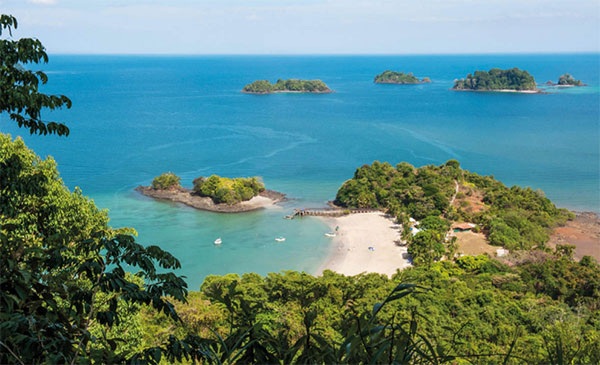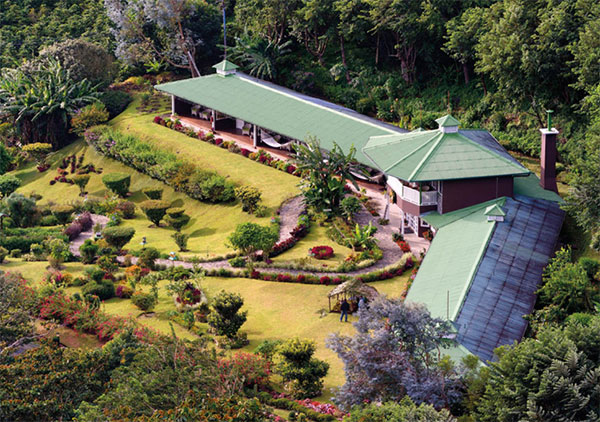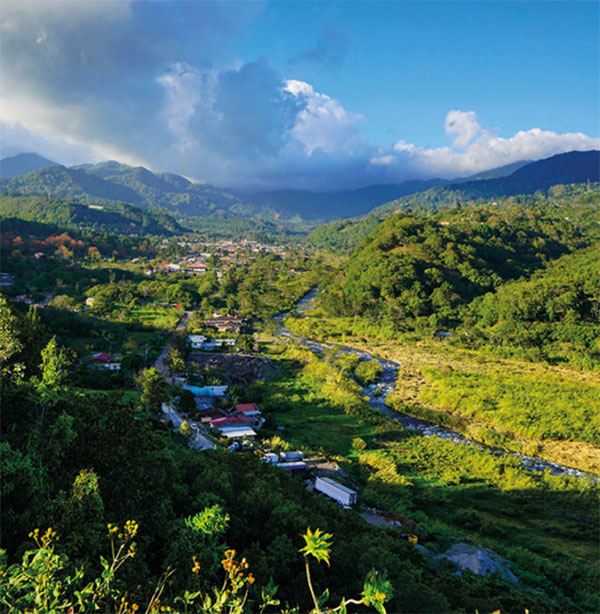POLLERAS OF AZUERO
The complexly designed pollera costumes are widely considered to be one of the world’s most beautiful forms of traditional dress. While the Spanish colonial dress was common in haciendas throughout Latin America, the most famous polleras come from the Azuero peninsula. Worn during special occasions, these polleras consist of a one-piece skirt layered with petticoats, which are intricately embroidered with floral designs and trimmed with lace. Accessories include gold and pearl jewelry called mosquetas and tembelques, which are passed down from one generation to the next. Each dress takes months to make and they can cost thousands of dollars. Panamanian women generally own two polleras in their life: one before they are 16 and another in adulthood.
Fact
The bajareque is a unique weather phenomenon that occurs from December to March, when a fine misting rain is pushed over from the Atlantic and into the highlands. The mist is so soft it ‘caresses the face,’ as locals like to say. The combination of sun, wind, and bajareque provides endless rainbows.
Isla Coiba
Panama’s largest island, Coiba % [map] (www.coibanationalpark.com) is one of the most pristine natural areas anywhere in Central America. The Coiba National Park encompasses 38 islands and islets, not to mention the waterways between them, extending to 270,128 hectares (667,500 acres), leading some to call it the region’s Galapagos. Primarily reached on day trips from the town of Santa Catalina, the park is home to the second-largest coral reef in the eastern Pacific, which is teeming with whales, hammerheads, nurse sharks, manta rays, crocodiles, and sea turtles, plus another 36 species of mammals on land. For almost 90 years, until 2004, there was a penal colony on Isla Coiba, which kept most tourists and developers away. Now that it’s gone, tourists are slowly arriving to dive the waters at Granito de Oro and hike the jungle trails of Coiba.

Looking out over the Coiba archipelago.
Alamy
The Chiriquí Highlands
Adventure seekers, bird-watchers, and coffee geeks are quickly discovering Panama’s highest mountains. The Chiriquí region, which has seen a surge of expats buying homes and opening businesses, is quickly becoming one of the most exciting destinations in Panama. It is rich in biodiversity, with the region’s unspoiled forests home to hundreds of rare birds, such as the resplendent quetzal and blue cotinga, while raging rivers are ideal for rafting and cloud forest trails that few have trodden await.
David
The transportation hub of western Panama and the country’s third largest city, David ^ [map] , a 45-minute drive from the Costa Rica border, is surprisingly flat. Set in the sweltering heat of the coastal plain, many only fly here or get off a bus before heading straight up the mountain to explore the cooler climate. Still, the town, while spread out, has a few blocks of colonial charm at Barrio Bolívar, and there are fine dining restaurants like Cuatro and swanky old hotels like the Gran Hotel Nacional (www.hotelnacionaldavid.com), which has added a quirky casino and movie theater complex.
Volcán and around
On the lower slopes of the Barú Volcano, the town of Volcán & [map] is characterized by its alpine-like climate and patches of small farms that surround a modern, bustling center. It’s a good base for exploring the highlands and sits in close proximity to several major attractions.
About 5.5km (3 miles) southwest of Volcán is Sitio Barriles (daily 8am–4pm), one of Panama’s few Pre-Colombian archeological sites. Discovered on the private land of the Landau family as they were building a coffee plantation, the site was once home to the Barriles culture, which was based in the area from 600–300 BC until the eruption of Barú forced them out. Hundreds of tools, ceramics, and a burial tomb with funerary urns have been found here, although only some of the finds are on display.

Finca Lerida, a coffee plantation in Boquete.
Getty Images
The rich volcanic soil surrounding Volcán has turned it into a haven for coffee farmers, and several offer tours of their plantations. Just west of town, the Janson Coffee Farm grows eco-friendly, organic beans that are handpicked and roasted in small batches, a process that can be seen on several short tours, run by Lagunas Adventures (www.jansoncoffee.com), of their plantation and production facility. More remote is Finca Hartmann (tel: 6450-1853), near the town of Santa Clara, 27km (17 miles) from Volcán. The stunning setting within the dense forests is a favorite for its bird-watching, as it sits in the north–south corridor of migrating birds. Short tours of the coffee production facilities are offered, though bird-focused visitors will often stay for a few days to camp out in the finca’s rustic cabins and hike through an extensive network of trails through the plantation.
Boquete and around
The major tourist destination in Panama’s highlands is without a doubt, Boquete * [map] , which has attracted a diverse population of North American and European expats who have moved here by the planeload to take advantage of the year-round, spring-like climate. On the shore of the Caldera River and backed by the steep slopes of the Barú volcano, the town itself is quite charming and provides easy access to numerous adventure activities and coffee fincas.
Boquete and its immediate surroundings are full of interesting amenities like the Boquete Brewing Company (www.boquetebrewingcompany.com), the Café Kotowa coffee shop, and Boquete Bees (www.natureboquete.com), a coffee farm and honey plant that produces gourmet honeys from native pollinators. There is a better selection of accommodations in Boquete than just about anywhere in Panama, ranging from the rustic Panamonte Inn & Spa, which dates from 1914 and is home to renowned chef Charlie Collins, to the posh Finca Lerida (www.fincalerida.com), on one of the region’s most historic coffee estates.
Some of Boquete’s most spectacular scenery is located on the hills above town, best reached by car. The paved Bajo Mono Loop, taking a left past the church at the end of town, gives phenomenal views of town below, as does the Volcancito Loop, reached by making a right after the CEFATI visitor center. On the main highway heading toward the Caribbean coast, the route winds through the lush forests to Finca La Suiza, set out over 81 hectares (200 acres). The property is intersected by three lengthy hiking trails through cloud and tropical forests that are home to waterfalls and spectacular vistas.

The small but popular town of Boquete.
iStock